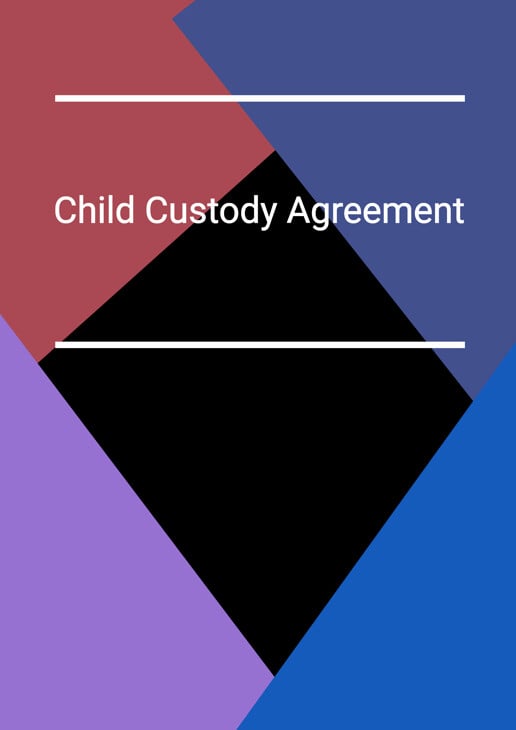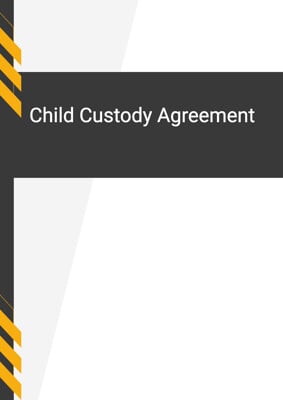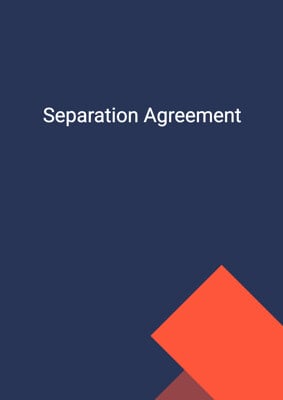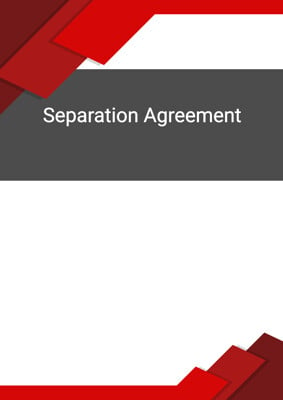How to Tailor the Document for Your Need?
01
Create Document
Fill in the details of the parties. You can click the "Fill with Member’s Information" button to complete it with information saved to your account.
02
Fill Information
Please fill in any additional information by following the step-by-step guide on the left hand side of the preview document and click the "Next" button.
03
Get Document
When you are done, click the "Get Document" button and you can download the document in Word or PDF format.
04
Review Document
Please get all parties to review the document carefully and make any final modifications to ensure that the details are correct before signing the document.
Document Preview
Document Description
The Child Custody Agreement is a legal document that outlines the terms and conditions relating to the care and custody of a minor child. It is made between two parties, referred to as the 'father' and the 'mother,' who are the parents or legal guardians of the child. The agreement begins with a brief introduction, stating the purpose of the document and confirming that no other minor child has been born during the marriage.
The agreement consists of several sections, each addressing a specific aspect of the child custody arrangement. The first section, titled 'Joint Custody,' establishes that both parents will have joint physical custody of the child. This means that they will share equal rights and responsibilities in making decisions regarding the child's upbringing, including matters of health, education, and religion.
The second section, titled 'Primary Custody,' designates the father as the primary custodial parent. The child will reside with the father at his residential address, and he will have the authority to make routine and day-to-day decisions regarding the child. The mother will also have primary physical custody during specific periods, as outlined in the agreement.
The third section addresses child support. It acknowledges the existence of a child support order issued by the court, which specifies the amount the non-custodial parent is responsible for paying. If there have been substantial changes in circumstances, the parties may agree to modify the terms of the child support order. The agreement also clarifies that the child support payment is responsible for medical and dental insurance premiums, as well as reasonable expenses related to the child's schooling.
The fourth section covers the exchange of the child between the parents. It states that the parties will choose a mutually agreeable location for the exchanges, and the costs associated with transportation will be borne by the party transporting the child. Both parties are encouraged to foster respect and affection for the other parent in the child.
The fifth section addresses holiday, special day, and vacation arrangements. It specifies which parent will have primary custody during certain holidays and allows for mutual agreement on custody arrangements for school breaks and special days. Each parent is entitled to two weeks of unrestricted access to the child for vacation, with advance notice to the other parent.
The sixth section includes additional provisions, such as respecting each other's parenting skills, making emergency decisions for the child's health and welfare, and maintaining open communication regarding contact information. It also emphasizes the importance of not changing the child's residence without prior notification and attempting to resolve any differences through mediation before seeking court intervention.
The agreement concludes with clauses on waiver, amendment, further assurance, successors and assigns, governing law and jurisdiction, severability, entire agreement, and counterparts. It states that any failure or delay in exercising rights or remedies does not waive them, and any amendments must be in writing and signed by both parties. The agreement is binding on the parties and their respective legal representatives, and it supersedes any prior agreements.
Schedule 1 of the agreement includes a copy of the child support order issued by the court, which provides additional details on the child support payment's responsibilities.
In summary, the Child Custody Agreement is a comprehensive document that establishes the rights, responsibilities, and arrangements for the care and custody of a minor child. It covers joint custody, primary custody, child support, exchanges, holiday arrangements, and additional provisions to ensure the child's well-being and the cooperation of both parents.
How to use this document?
1. Determine joint custody: Both parties should agree to have joint physical custody of the child, meaning equal rights and decision-making authority.
2. Establish primary custody: Designate one parent as the primary custodial parent, with the child residing at their residential address and granting them routine decision-making authority.
3. Address child support: Acknowledge any existing child support order and, if necessary, agree to modify it based on substantial changes in circumstances. Specify the amount, payment terms, and responsibility for insurance and education expenses.
4. Arrange exchanges: Choose a mutually agreeable location for exchanging the child and clarify that transportation costs are the responsibility of the transporting party.
5. Plan holidays and vacations: Determine which parent will have primary custody during specific holidays and allow for mutual agreement on custody arrangements for school breaks and special days. Each parent should have up to two weeks of unrestricted access to the child for vacation, with advance notice.
6. Include additional provisions: Emphasize respect for each other's parenting skills, decision-making authority for emergencies, and the importance of maintaining open communication. Address access to information and notification of residence changes. Encourage mediation for dispute resolution.
7. Understand waiver and amendment: Clarify that failure to exercise rights or remedies does not waive them, and any amendments must be in writing and signed by both parties.
8. Ensure further assurance: Commit to taking necessary actions and executing documents to give full effect to the agreement.
9. Consider successors and assigns: State that the agreement is binding on the parties and their legal representatives, heirs, administrators, executors, successors, and permitted assigns.
10. Determine governing law and jurisdiction: Specify the jurisdiction and governing law applicable to the agreement.
11. Address severability: State that if any terms are held invalid, the agreement should be interpreted as if those terms were not included.
12. Confirm entire agreement: Specify that the agreement contains the entire understanding between the parties, superseding any prior agreements.
13. Execute counterparts: Sign the agreement in counterparts, with each counterpart having the same effect as the others.
Please note that this guidance provides a summary of the steps involved in using the document. It is important to review the actual document for complete and accurate instructions.
Not the right document?
Don’t worry, we have thousands of documents for you to choose from:




















